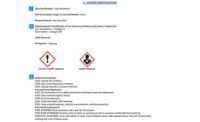Where chemicals are concerned, the world has changed dramatically in the last few years. A growing chorus of community, political and regulatory stakeholders is calling for greater chemical responsibility. Think of the biggest stories of the last few years that were not centered on war or the economy. They include the Deepwater Horizon oil spill and subsequent cleanup during the spring/summer of 2010; the West, Texas, fertilizer plant explosion in April 2013; and the Charleston, West Virginia, hazardous chemical spill this past January that contaminated the community’s water supply.
Public patience with irresponsible companies has grown thin, especially for those unable to quickly and concretely convey the exact nature of the hazards associated with the chemicals in their charge. Because of the cases like the ones listed above, agencies like the EPA and OSHA are gaining regulatory leverage. For companies that use chemicals, the days of guessing are over. You must know all of the chemicals in your care and have an up-to-date safety data sheet for each; it’s that simple.
The rise of GHS
Of course, it is not simple at all.
Thanks to OSHA’s adoption of the United Nations’ Globally Harmonized System of Classification and Labelling of Chemicals, safety data sheets in the U.S. are undergoing their biggest transformation in decades. Under the GHS model, safety data sheets are standardized and uniform, with 16 strictly ordered sections.
That sounds like a good thing, and once every chemical manufacturer and distributor in the U.S. completes the process of updating their safety data sheets to this format, it probably will be. But right now, it is causing some headaches.
First, employers and safety professionals have a lot of uncertainty and confusion about when safety data sheets will be ready in the new format. Next, many chemical manufacturers have decided to wait until the last minute to make the updates. And finally, many chemical manufacturers that are not waiting are moving toward the GHS format in stages, creating a strange breed of safety data sheets that contain a hybrid of GHS elements mixed with decidedly non-GHS elements. These documents are confusing. At my company, we affectionately call them “Frankenstein MSDSs.”
The next HazCom deadline
By June 1, 2015, chemical manufacturers and distributors are expected to have reclassified their chemicals and updated their labels and safety data sheets in the GHS format. Many safety professionals and employers know the SDS change is coming but are unaware of the phased-in compliance deadline, so in GHS workshops and Webinars, you’ll often here the question: “Where can I go to get all of the new safety data sheets?”
Nothing is preventing chemical manufacturers or distributors from making those changes today. Many have, but the great majority has not. That means there is no one place safety professionals can go today to get all of the safety data sheets in the new format…most safety data sheets have not yet been updated. Nonetheless, MSDS management solutions can greatly aid in the search.
Some confusion about the availability of the new documents comes from the fact that OSHA required employers to train workers to understand the new format by December 2013. Many people thought, erroneously, that the safety data sheets were already finished.
This leads to the second issue: A good number of chemical manufacturers and distributors are waiting to update their documents until the deadline is nearer. This approach is likely to create havoc in the chemical supply chain in the months ahead.
Companies that purchase chemicals from upstream suppliers as raw materials for their products will likely not update their safety data sheets until after their suppliers do; the result may have them falling on the wrong side of the deadline.
Moreover, rather than having an consistent steady stream of updated documents, end users of chemicals — the employers —are likely to receive updated safety data sheets in intervals with periods of no new documents followed by periods great activity. This could be confusing and cumbersome, because as new documents come in, employers need to compare them to the old safety data sheets to see if any new hazards have been identified, and if so, must train their employees on those hazards.
Regardless, employers should be preparing for the great “MSDS Churn” which will result in basically their entire safety data sheet libraries being updated in a short timeframe.
Frankenstein MSDSs
Then there is the issue of “Frankenstein MSDSs.” Under HazCom 1994, safety data sheets were commonly produced in 8-part, 12-part and 16-part formats (and everything in between). Until now, OSHA didn’t dictate the number of sections or the format in which the information was to be presented.
With HazCom 2012, the agency has decided upon a 16-section document. The new format puts the most critical information needed during an emergency in the first half of the document (sections 1-8), and the less time-sensitive information in the second half of the document (sections 9-16).
Additionally, section two of the new safety data sheet is reserved for hazard identification information, which includes the new GHS-styled hazard elements required on the chemical’s corresponding new safety label (e.g., pictograms, signal words, hazard statements, and precautionary statements). Along with the new format, OSHA has renamed the documents safety data sheets. Instead of calling them MSDSs, once in the new format, OSHA now refers to them as SDSs.
The problem for employers is that many chemical manufacturers are making the switch from MSDSs to SDSs in stages. That is, the marketplace is seeing safety data sheets that contain GHS information, but with the wrong number of sections, or the right number of sections, but with GHS information that is either incomplete or a mish-mash of hazard information and regulatory ratings. It requires a focused eye to discern whether a new safety data sheet is fully HazCom 2012 compliant or merely trending in that direction.
Regardless, employers need to treat all new safety data sheets with respect. Even if it is not fully in the GHS style, it may contain new or additional hazard information that employees have a right to know, and on which employers are required to train.
Simple steps toward GHS compliance
Here are 5 steps for managing safety data sheets during this transition to the GHS format.
1. Do a physical inventory of your hazardous chemicals. Know what you have. Don’t guess!
2. Make sure you have the most up-to-date safety data sheet for every chemical on your list.
3. Prepare for the “MSDS Churn.” Many companies are turning to electronic management of safety data sheets to help them control the influx and multiple versions of MSDSs they will be getting.
4. Carefully review every safety data sheet that comes into your facility, especially the Frankenstein MSDSs, to see if there are new hazards your employees need to be trained on.
5. Talk to your suppliers about their plans to update to the GHS format. Apply some bottom-up pressure to help accelerate the transition.
By taking a few measured steps today, safety professionals — and everyone in the life cycle of hazardous chemicals — can keep compliant and safeguard employees during the messy transition to GHS. Additionally, a number of great resources, including newer, more affordable cloud-based applications, can help ease the burden of tracking chemicals and related critical safety information. OSHA’s next big GHS deadline is June 2015, but what we do in 2014 will help determine whether this transition to GHS is an easy one or a hard one.




